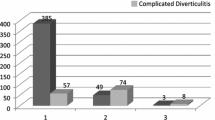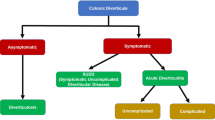Abstract
Background: In the large bowel, resection of the sigmoid colon is the most commonly performed laparoscopic intervention because large bowel lesions often are located in this part of the bowel and the procedure technically is the most favorable one. A number of publications involving case series or the results of highly experienced individual surgeons already have confirmed the feasibility of laparoscopic resection in cases of diverticulitis. The aim of the present prospective multicentric investigation was to check the results obtained by a large number of surgeons performing laparoscopic resection of the sigmoid colon for diverticulitis in various stages of severity.
Results: Between January 8, 1995 and January 1, 1998, the Laparoscopic Colorectal Surgery Study Group recruited 1,118 patients to the prospective multicenter study. Diverticulitis of the sigmoid colon, which accounted for 304 cases, was the most common indication for laparoscopic intervention. In most of these patients undergoing laparoscopic surgery (81.9%), the diverticulitis manifested as acute phlegmonous peridiverticulitis, recurrent attacks of inflammation, or stenosis. Complicated forms of diverticulitis in Hinchey stages I to IV and late complications of chronic diverticular disease with fistula formation and bleeding accounted for only 18.1% of the cases. For the overall group, the conversion rate was 7.2%. Patients with less severe diverticulitis (i.e., those presenting with peridiverticulitis, stenosis, or recurrent attacks of inflammation) had a conversion rate of 4.8% and the rate for complicated cases was 18.2%. Regarding laparoscopically completed interventions, 3 of 282 patients died (1.1%). In the group of patients with peridiverticulitis, stenosis, or recurrent attacks of inflammation the overall complication rate was 14.8%. The group with perforated diverticulitis in Hinchey stages I to IV or those with fistula and bleeding, the corresponding rate was 28.9%, and after conversion it was 31.8%.
Conclusions: Laparoscopic colorectal interventions in sigmoid diverticulitis are, for the most part, carried out as elective procedures for peridiverticulitis, stenosis, or recurrent attacks of inflammation. The conversion, complication, and mortality rates associated with these interventions are acceptable. Laparoscopic procedures in Hinchey stages I to IV sigmoid diverticulitis and in the presence of fistula and bleeding are more likely to be associated with complications, and should be carried out only by highly experienced laparoscopic surgeons.
Similar content being viewed by others
Author information
Authors and Affiliations
Consortia
Additional information
Received: 26 March 1998/Accepted: 13 October 1998
Rights and permissions
About this article
Cite this article
Köckerling, F., Schneider, C., Reymond, M. et al. Laparoscopic resection of sigmoid diverticulitis. Surg Endosc 13, 567–571 (1999). https://doi.org/10.1007/s004649901042
Published:
Issue Date:
DOI: https://doi.org/10.1007/s004649901042




